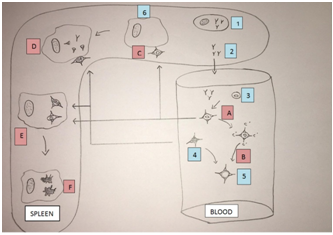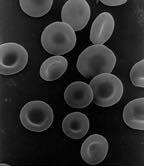|
Size: 3251
Comment:
|
Size: 3317
Comment:
|
| Deletions are marked like this. | Additions are marked like this. |
| Line 5: | Line 5: |
| Paul Ehrlich in the beginning of the 20th Century proposed the idea of “horror autotoxicus”. This idea suggested that any biological organism is able to endure and recognise its own tissue. However, had the above system become intolerant, an autoimmune disease would be caused. In the following passage the definition of Immune Mediated Haemolytic Anaemia will be discussed in depth. Following, its causes will be detailed using data retrieved from various scientific articles and specialisation books. Moreover, the symptoms presented in the disease will be stated, that one along with the diagnostic methods and tests can use to identify the disease. Lastly, the treatments available and their effectiveness will be mentioned, using proof from the findings collected from the aforementioned sources. | Paul Ehrlich in the beginning of the 20th Century proposed the idea of “horror autotoxicus”. This idea suggested that any biological organism is able to endure and recognise its own tissue. However, had the above system become intolerant, an autoimmune disease would be caused.[1] In the following passage the definition of Immune Mediated Haemolytic Anaemia will be discussed in depth. Following, its causes will be detailed using data retrieved from various scientific articles and specialisation books. Moreover, the symptoms presented in the disease will be stated, that one along with the diagnostic methods and tests can use to identify the disease. Lastly, the treatments available and their effectiveness will be mentioned, using proof from the findings collected from the aforementioned sources. |
| Line 15: | Line 16: |
| Most commonly observed in dogs and cats but probably occurs in all species. All breeds of dogs may be affected especially Cocker Spaniels. Other susceptible breeds are Bichon Frise, Miniature Pinschers, Rough-coated Collies, and Finnish Spitz. Sex is also considered to play a role in IMHA development as there are more cases of IMHA in females especially spayed ones. Blood type is assumed to play a role in the susceptibility for the disease, with DEA4 being the most common. | Most commonly observed in dogs and cats but probably occurs in all species. All breeds of dogs may be affected especially Cocker Spaniels. Other susceptible breeds are Bichon Frise, Miniature Pinschers, Rough-coated Collies, and Finnish Spitz. Sex is also considered to play a role in IMHA development as there are more cases of IMHA in females especially spayed ones. Blood type is assumed to play a role in the susceptibility for the disease, with DEA4 being the most common.[2] |
| Line 17: | Line 18: |
| {{attachment:table.png|pop-up text}} < > '''Table 1'''< >''The most common blood type among dogs with IMHA was DEA 4 and Cocker Spaniels seem to be the most susceptible to the disease'' | {{attachment:table.png|pop-up text}} < > '''Table 1'''< >''The most common blood type among dogs with IMHA was DEA 4 and Cocker Spaniels seem to be the most susceptible to the disease''[3] |
| Line 21: | Line 22: |
| {{attachment:RBC.png|pop-up text}} | {{attachment:RBC.png|pop-up text}} < >'''Fig 2.'''< >''Normal Red blood cells (EM)'' [4] |
Itt írjon a(z) ImmunhemolyticAnemia-ról/ről
Introduction
Paul Ehrlich in the beginning of the 20th Century proposed the idea of “horror autotoxicus”. This idea suggested that any biological organism is able to endure and recognise its own tissue. However, had the above system become intolerant, an autoimmune disease would be caused.[1] In the following passage the definition of Immune Mediated Haemolytic Anaemia will be discussed in depth. Following, its causes will be detailed using data retrieved from various scientific articles and specialisation books. Moreover, the symptoms presented in the disease will be stated, that one along with the diagnostic methods and tests can use to identify the disease. Lastly, the treatments available and their effectiveness will be mentioned, using proof from the findings collected from the aforementioned sources.
What is Immune Mediated Haemolytic Anaemia
Immune anaemia is caused due to antibody adherence to the cell membrane of a red blood cell which may or may not have a complement fixation. This interaction causes the red blood cell to become spherical which reduces their lifespan by either causing their lysis by the monocytes and phagocytes of the body’s immune system or when the cell membrane forms a complement with the immunoglobulins and an attack complex is created which causes intravascular haemolysis. (Fig. 1)
 < >Fig 1.< >1 – Lymphocyte, 2 - Free Antibodies, 3 – Erythrocyte, 4 – Spherocyte, 5 – Ghost Erythrocyte, 6 – Macrophage A – Complement reaction, B – Intravascular haemolysis, C – Attachment to macrophage, D – Partial phagocytosis, E – Erythrophagocytosis, F – Extravascular haemolysis.
< >Fig 1.< >1 – Lymphocyte, 2 - Free Antibodies, 3 – Erythrocyte, 4 – Spherocyte, 5 – Ghost Erythrocyte, 6 – Macrophage A – Complement reaction, B – Intravascular haemolysis, C – Attachment to macrophage, D – Partial phagocytosis, E – Erythrophagocytosis, F – Extravascular haemolysis.
Immune mediated haemolytic anaemia is serologically caused by two types of antibodies (or no detectable antibodies): warm-antibodies (usually IgG or IgA), cold-antibodies(usually IgM). Further classification exists when considering the causes, Idiopathic (primary) and Symptomatic (secondary) immune haemolytic anaemias. The above could be even further categorised as being isoimmune, drug-induced, associated with infectious disease or associated with lymphoid or other malignancy.
Idiopathic Immune Haemolytic Anaemia
Most commonly observed in dogs and cats but probably occurs in all species. All breeds of dogs may be affected especially Cocker Spaniels. Other susceptible breeds are Bichon Frise, Miniature Pinschers, Rough-coated Collies, and Finnish Spitz. Sex is also considered to play a role in IMHA development as there are more cases of IMHA in females especially spayed ones. Blood type is assumed to play a role in the susceptibility for the disease, with DEA4 being the most common.[2]
 < > Table 1< >The most common blood type among dogs with IMHA was DEA 4 and Cocker Spaniels seem to be the most susceptible to the disease[3]
< > Table 1< >The most common blood type among dogs with IMHA was DEA 4 and Cocker Spaniels seem to be the most susceptible to the disease[3]
When viewed under the microscope anaemia is macrocytic and slightly hypochromic, with a normal haemoglobin concentration. Spherocytosis, leptocytosis and marked anisocytosis are observed. (Fig. 3)
 < >Fig 2.< >Normal Red blood cells (EM) [4]
< >Fig 2.< >Normal Red blood cells (EM) [4]
